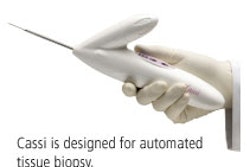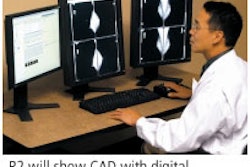Two new papers in the British Medical Journal served up backhanded compliments to mammography. The first acknowledged that breast cancer screening does reduce overall mortality, but noted that it still carries a 10% rate of overdiagnosis. The second study suggested that as noble as public screening programs may be, women are dangerously misinformed as to the benefits and drawbacks of participation.
Malmö follow-up
Previous studies have indicated that the rates of overdiagnosis in breast cancer screening may range from 5% to 50%. Can a more exact overdiagnosis figure be pinpointed? The group from Lund University and Malmö University Hospital in Malmö, Sweden, sought the answer to that question using the Malmö mammographic screening trial.
The trial ran from 1976 to 1986. In brief, all Malmö women born between 1908 and 1932 were randomly invited to either undergo screening mammography or be part of the no-screen control group. Ultimately, 21,088 women were in the screening group and 21,195 were in the control group. Women were invited to undergo screening at intervals of 18-24 months. Five rounds of screening were completed.
During the trial, 2,525 breast cancer cases were identified: 1,320 in the screening group, of which 91% were invasive cancers, and 1,205 in the control group with 93% being invasive cancers (British Medical Journal, October 15, 1988, Vol. 297:6654, pp. 943-948).
For the latest study, Dr. Sophia Zackrisson and colleagues divided the data from the Malmö participants into two groups: period 1 when the trial was in progress and period 2 referring to follow-up time through 2001.
"Fifteen years after the trial ended the invited group showed a 10% significantly higher incidence of breast cancer. Despite differences in exposure to screening, the older and the younger women had similar relative rates of overdiagnosis (10% and 8%)," they concluded (BMJ, March 2, 2006).
During period 1, the incidence of breast cancer was 24% higher in the invited group than in the control group. During period 2, the incidence was 5% lower in the invited group, which the authors deemed a "modest reduction."
Among the 584 deaths in women in the invited group, 36.3% were because of breast cancer. In the control group, 46.6% of the 274 deaths were attributable to breast cancer.
In women age 55-69 at randomization, the relative rates of overdiagnosis were 1.32 during period 1 and 0.92 during period 2.
The authors did not offer particularly detailed reasons as to the factors that influence overdiagnosis except for a decrease in attendance with age. However, the Malmö women were more likely to have continued with regular screening even after the trial ended, they stated.
In a BMJ commentary, Dr. Henrik Møller and Dr. Elizabeth Davies from King's College London praised Zackrisson work as "informative analysis." They said that the first step toward reducing overdiagnosis was to "appreciate the reality of overdiagnosis and its likely magnitude. Zackrisson et al's study should inspire similar estimations … in other populations" (BMJ, March 2, 2006).
Content versus coercion
In the second paper, Dr. Karsten Juhl Jørgensen and Dr. Peter Gøtzsche examined invitations to public mammography screening programs in several countries, including Australia, Canada, Denmark, Sweden, and the U.K.
The authors are from the Nordic Cochrane Centre in Copenhagen. Gøtzsche has previously penned several controversial articles that have recommended against screening mammography, calling it unjustifiable and failing to show a survival benefit.
This time, Gøtzsche and his co-author pointed out that program coordinators who provide education information to the women also have a mandate to make sure the program succeeds, leading to a potential conflict of interest.
Based on their analysis of screening invitations, the duo determined that the majority of programs (97%) sugarcoat the benefits of screening by failing to explain the absolute risk reduction associated with regular mammographic exams. The literature also did not mention the effect of screening on mortality, the danger of overdiagnosis, and/or subsequent overtreatment.
They also felt that 95% of the invitations relied on "suggestive headlines," such as "Have a screening mammogram, it may save your life" (BMJ, March 4, 2006, Vol. 332:7540, pp. 538-541).
They criticized program literature for downplaying harm (besides pain), for offering misleading figures on mammographic sensitivity, and for relying on scare tactics.
"Fear of cancer seems to increase participation in breast cancer screening, and the frequent mention of lifetime risk of developing breast cancer ... could scare some women to participate without considering the harms," they wrote.
The authors suggested that information sent out with program invitations should be more balanced, using absolute numbers to describe benefits and harms. They also stated that the people responsible for pooling the information should be different than those who run the program itself.
In a BMJ commentary, Dr. J. Michael Dixon from Western General Hospital in Edinburgh, Scotland, called attention to the updated U.K. screening program leaflet, which describes the pros and cons of screening.
Dixon also stressed that the results of a February 2006 report by the National Health Service's advisory committee on breast cancer screening provide strong evidence that such programs do save lives. The report estimated that mammographic screening saves 1,400 lives annually in the U.K. Also, clinical improvements, such as double-reading and better machines, have made screening more sophisticated and reliable.
"It is finally time to accept that although screening by mammography is far from perfect, it is worth while," Dixon wrote. "Criticisms about the early trials are no longer relevant. Breast screening has moved on and is looking to the future" (BMJ, March 4, 2006, Vol. 332:7540, pp. 538-541).
By Shalmali Pal
AuntMinnie.com staff writer
March 3, 2006
Related reading
U.K. group accuses breast cancer screening advocates of disinformation, July 11, 2003
Mammography screening effective when data are analyzed correctly, February 1, 2002
American Cancer Society blasts Danish mammography study, January 10, 2000
Copyright © 2006 AuntMinnie.com



















